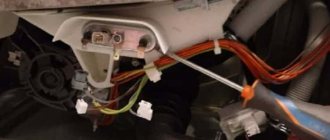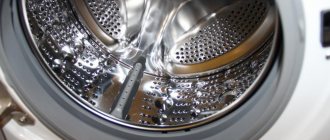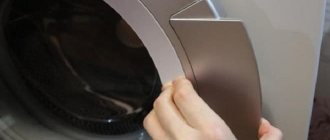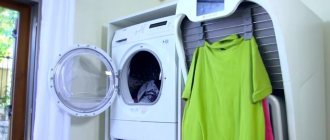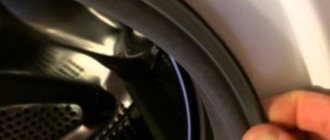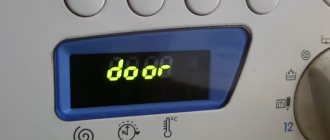The machine does not carry out the washing program, begins to supply water, then begins to drain it constantly, while the program selection switch rotates.
The problems began after they forgot to lower the drain hose into the bathtub; it was lying on the floor and water accumulated about 3 centimeters in the bathroom.
What I did on my own, having studied similar symptoms on the Internet: * pump filter, checked - not clogged, rotates; * wires, contacts, control module board - without visible damage and without traces of water ingress; * the motor appears to be in good order, I removed and checked the brushes - they were worn out, but they were still of sufficient length and came out freely; * I tried to “reset” the program using the following algorithm - I set the program dial to the “point”, then turned it on, and after a while turned it off (with the power button), then set the washing program and turned on the power - the problem remained.
Before this, the machine had not been repaired, it served for about 7 years, sometimes it had “slips” - sometimes the spin cycle did not work during the washing program. But this is rather an exception.
I read and did everything that could be found on the forum, but there is no “key” to perform the check on a PC.
Source
Ariston washing machine does not drain water - what to do
Often housewives and consumers are faced with the fact that the Ariston washing machine does not drain water. This creates certain difficulties during further operation. It’s not just the inability to open the door, get things out and start the drain, but the lack of further spinning and completing the wash cycle. As a result, water stagnates inside, which leads to oxidation of the drum and the appearance of mold. Calling a technician is always expensive, so this article will look at independent troubleshooting methods.
Unit features
Thanks to the versatility and high quality of the washing machine, users note excellent results at all stages of washing. The unit is economical in terms of water and electricity consumption. Users note the presence of convenient programs for operating the device. So, for washing delicate items, it is recommended to use the “Golden Cashmere” option. If you need to refresh a small amount of colored laundry, we use the daily wash option.
Turning on the washing machine
For washing moderately soiled items, it is recommended to use the quick wash cycle for 90 minutes. If there is a need to delay the start time of the unit, Ariston Margarita 2000 (ALS88X) will allow you to do this with the press of one button.
Front side of the washing machine
Why doesn't the equipment drain the water?
Causes of problems in Ariston:
- Program crash. Perhaps there was a network overvoltage or a power outage, which allowed the Ariston machine to “think” about performing the task at hand, specifically about draining, or to stop working completely. Knocking on the top cover or the presence of heavy objects similarly cause a malfunction, which also stops the drain.
- The drain hose is blocked by foreign objects.
- Clogged sewer system.
- Foreign objects have entered the filter.
- Pump or pump failure.
- Extension of the hose or placement at an unacceptable level.
- Wiring open or shorted.
Some of the problem can be solved yourself, while the machine will remain in working order. The owner of Ariston is lucky if his machine is equipped with the Smart diagnostic function. Using special keys, Wi-Fi and a smartphone, the machine is diagnosed, and after a few seconds a notification is received about the breakdown, the possible cause and how to fix it. This option is factory-installed, but is installed in more modern Ariston models.
Diagnosis and troubleshooting
Program crash
- Restart the program. Press start wash cycle and wait. If there is no reaction, turn off the machine and start draining.
- Remove heavy objects from the lid and try to restart the drain.
- If the problem is not solved, then the problem is not in the program.
Hose
- Check the bend radius. Minimum 50, maximum 80 cm. If it is bent or not bent, then the water simply will not reach the drain. The machine will receive a signal to the built-in sensors, and the command will remain unfulfilled. You can fix the problem using a special clamp that comes with the washing machine.
- Possible squeezing. This happens if you step on or knock over something heavy. The situation will not only stop the cycle, but also break the rubber. Remove any foreign objects.
- Check the connection. The fastenings could come off, and the smart machine decided not to drown the neighbors below.
Sewerage
- Open the tap or flush the toilet tank; if the water does not drain, you need to clean the system.
- When disconnecting the drain source from the corrugation, the washing machine must be turned off.
- Clear the blockage.
Filter
- Turn off the power to the washing machine.
- Place a towel underneath.
- Open the filter protection. It is located at the bottom on the right side (if the car is facing the owner).
- Turn the cap to the right and unscrew it.
- Wait until the water stops flowing.
- Remove the filter and inspect for excess contents: buttons, coins, washing powder.
- Rinse the part. The water should not be hot.
- Rotate the impeller (located behind the filter); if it moves freely and does not jam, then the pump is in order.
water pump
- After draining the water and removing the filter, start the spin cycle.
- If the impeller remains motionless, there may be a problem with the pump or pump.
- When the pump makes an unusual noise, water has most likely leaked into it. In such cases it must be replaced.
- To diagnose, you need to remove the lid of the washing machine.
- You can fix the problem yourself if, after a visual inspection, minor damage is visible.
- Did the examination yield no results? Then contact a specialist who carries out highly qualified repairs of Ariston machines.
Wiring
- Remove the top cover and inspect the wires.
- Perhaps the previous spin helped to disconnect the block of wires from the board. Return the block to its original position and restart Ariston.
- Check for moisture or broken contacts
What could have happened?
It’s very easy to notice that the washing machine takes in and immediately drains water. Firstly, the machine does not proceed to the next washing stage. Secondly, you will hear the constant murmur of liquid flowing into the pipe. This malfunction can be caused by:
- improperly positioned drain hose;
- incorrectly functioning pressure switch;
- broken heating element;
- damaged drain valve;
- failed control module.
If you connect the drain hose below the required level, the water will leave the tank by gravity. Therefore, it is important to position the sleeve as indicated in the instructions, under a certain bend. The outlet point should be at a distance of 60-80 cm from the floor.
A faulty level sensor will transmit incorrect information to the “brain”. So, when the tank is empty, the pressure switch will report an overflow and the drain will start. Therefore, water will accumulate and immediately go down the drain.
The electronic unit controls all processes. If the control module breaks down, the SMA begins to behave incorrectly and may well collect and immediately drain water. In this case, in-depth diagnostics of the board will be required.
According to statistics, it is on Aristons that most often endless drainage and collection of water is observed due to improper connection of the drainage hose or a faulty heating element.
We'll tell you what to do if the machine doesn't wash. Let's figure out where to start diagnosing the Ariston washing machine. The problem with constant supply and drainage of water must be solved immediately, without delay.
The washing machine does not drain or spin
The spin mode starts if the water drainage works correctly. If, after solving the drainage problems, the spin still does not start, then there are likely more complex problems.
Causes and solutions
- Board malfunction. Usually, error F18 is displayed on the display, which means this breakdown. Unfortunately, you won’t be able to fix the problem yourself, as you will need to reflash the system.
- The drain has failed . Fix the problem and restart the program.
- Press failure . Remove the top and inspect the load. Replace if necessary.
- Failure of the tachogenerator (Hall sensor) . Check the fastening; if the part is loose, it needs to be tightened. Rotate the drum manually and substitute the voltage measurement (no more than 0.2). Is the data positive? Then the probability of a defect is contamination. Clean the sensor and reinstall it according to the instructions. In case of mechanical damage, the part needs to be replaced.
- The bearing broke . It is easy to detect a breakdown: when the drum rotates, a loud knock or hum is heard. In this case, the bearing must be replaced.
- Engine failure. The Ariston machine only has a commutator motor; most likely, the brushes are worn out or the belt is broken. Wear of parts is visible visually. You can make the replacement yourself.
- Control module . Water got in, excessive vibration, the car suffered a strong blow, this leads to a decrease in the functionality of the Ariston “heart”. In such cases, the module is visually inspected for moisture and disconnected contacts. If necessary, it can be removed and cleaned. If, after manipulations, the program does not start, or the indicators begin to blink, it is recommended to contact a washing machine repair shop.
After all of the above, it became clear what to do if the Hotpoint Ariston washing machine does not drain water or spin, and how to fix any damage yourself.
The positive aspects of DIY repairs include saving money. But it takes a lot of time to diagnose, disassemble and fix problems.
Calling a technician and repairing it can be expensive, however, it will save time and provide professional and quick assistance to the washing machine. In addition, a qualified specialist will quickly determine whether the equipment can be repaired or whether it will be easier to purchase a new assistant.
Source
How to start the unit
When turning on the machine for the first time, the user sees that the indicator indicated by the letter “A” is lit. This means that the device is in standby mode and ready to use. To select the desired option, turn the handle and stop it near the inscription with the desired program. At this moment, the indicator switches to the letter “B”, which tells the user that the device is ready to perform the task. After the final selection of options and operating conditions, the indicator switches to the letter “C”. The machine will start.
Control buttons
If it is necessary to stop the device, turn the program knob to the reset position. To install a delayed strat, set the handle to the “KA” indicator and press “Reset”. The machine will stop working for 5 seconds. To extend the time, select the appropriate indicator on the display.
Washing machine diagram
Fault diagnosis
First of all, we checked how the washing machine is connected to the drain, since this is a common problem and often leads to unpredictable behavior of the SMA, especially Ariston of this series.
This is what our car looks like with the back cover removed.
It is connected to the drain correctly, and a siphon effect cannot occur, so we exclude this reason. Then we check the heating element. The tubular electric heater is located in the tank at the bottom, usually at the back of the washing machine. To access it, remove the back cover by unscrewing the screws with a Phillips screwdriver.
We call the resistance with the limit set at 200 Ohms. The heating element in question showed a value of 50 Ohms. Everything is fine here.
IMPORTANT! Before measuring, remove the terminals from the contacts! Because the heating element included in the electrical circuit may show incorrect resistance.
Then we check the heater for breakdown. To do this, set the maximum resistance limit that is available on the multimeter or tester. It is necessary to understand that megaohms are needed, and preferably 40 megohms. Otherwise, the result will be unreliable.
Then we apply one end of the probe to the body of the heating element, and the second in turn, first to the first contact, then to the other. If there is a breakdown, the tester will show a value other than 1.
I work in the household appliance repair industry. Extensive experience in restoring washing machines and dishwashers.
Heating element of a washing machine with reset terminals.
In this case, the multimeter showed that there was no breakdown to the housing. We decided to conduct a more extensive diagnosis. Namely, they started the machine in the “wash” mode, with the heater previously turned off.
I work in the household appliance repair industry. Extensive experience in restoring washing machines and dishwashers.
Ariston, at least this model, starts without a heating element. What actually happened was that the machine took in water and the drum began to spin. There was no emergency drain!
For the purity of the experience, we connected our own heater to the washing machine. In this case, the SMA continued to function normally. When connecting your electric heater to the outside of the tank, you need to understand that heating in modern washing machines turns on 8-15 minutes after the start of the program. That is, during this period you don’t have to worry about overheating.
Connecting the heating element without changing it in the tank.
Online diagnostics of a washing machine
If your machine stops washing or rinsing clothes normally, then some kind of malfunction or breakdown has occurred. You can try to find the problem yourself.
Select which operation your washing machine does not perform:
1. Doesn’t drain 2. Doesn’t rotate the drum 3. Doesn’t spin clothes 4. Noises, knocks, buzzes when spinning 5. Doesn’t turn on
Dismantling
It all depends on how “sour” the heating element is. The pulling technique is slightly different, depending on the material. There are also plastic tanks, and their walls are thicker. But at the same time, the rigidity is much less and this must be taken into account in the work, since force often has to be applied.
The process of removing the heater.
First, unscrew the bolt located in the middle, using a size 8 or 7 socket wrench. Do not unscrew it completely, otherwise it will be difficult to remove the heater. After that, press on the screw, pushing it inward. And the second half of the heater will move a little deeper, releasing the clamp of the black rubber gasket.
Then you need to use slotted screwdrivers (I usually use two) to pull the heating element cover out of the tank. You will be able to pull it out 1-1.5 cm. The heater will not go any further so easily. It will be held in two parts.
The first is the mount in the tank where the heater goes. We took a picture of what it looks like inside the tank.
Heating element between the tank and the drum wall.
You can see that there is a mount in the middle. As a rule, there are no problems with it, but there are situations when the heater is welded (stuck) to this mount, and it is necessary to apply force to unhook it from it.
The second part that holds the heater is rubber. The fact is that it seems to swell (expand). And this expansion is located inside the tank, and it turns out to be larger than the hole for the heater. This is actually the basis for the mechanism for fastening the heating element and isolating it from water leakage.
In order to pull out the heater, you need to show some skill. It is most convenient to use a small screwdriver and pliers. We use pliers to pull the heating element away from the tank, and stick a screwdriver inside and try to pull out the thickening of the rubber gasket. And so on throughout the semicircle of the hole.
Heater removal process

